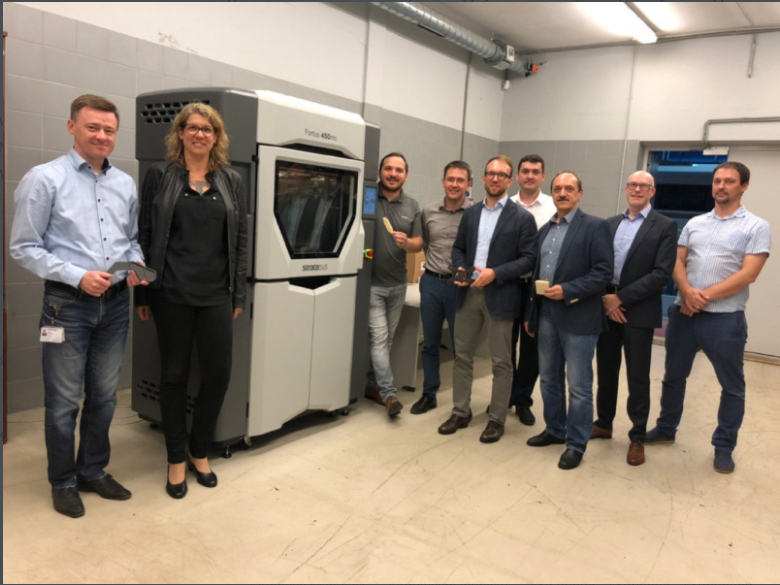Having previously utilized Stratasys’ 3D printing systems to fabricate spare parts for the German and UK rail industries, Siemens Mobility Services has increased its investment in Stratasys’ 3D printing technology to expand its rail maintenance operation in Russia.
Two new industrial-grade Stratasys Fortus 450mc 3D printers will be used for spare part production to support the 13 additional high-speed Velaro trains Siemens Mobility will be building for Russian train company RZD.
The 30 year maintenance project
The 13 new trains will be added to an existing fleet of 16, with a 30 year agreement to maintain and service the trains also in the deal. This third Velaro order from RZD will bring the total number of high-speed trains to 29.
The two Stratasys 3D printers have already been installed in St. Petersburg and Moscow, allowing the Siemens Mobility team to rapidly and cost-effectively 3D print rail replacement components on-demand. The major investment marks the initiation of Siemens Mobility’s ‘Easy Sparovation Part’ network in Russia, which aims to facilitate the in-house replacement of spare train parts through the selective 3D printing of a digital inventory of original train components.
For the next 30 years, Siemens Mobility Russia expects a fleet availability record of more than 99%. By storing all component data online in a centralized database, the team can access, print and replace faulty parts at rapid rates, ensuring the downtime on trains is kept to a minimum.

“These availability figures would be physically impossible to achieve through external part sourcing and traditional manufacturing techniques alone, but Stratasys’ FDM 3D printers gives us the capability to cost-effectively produce the parts in-house, partially eliminating the need for warehousing or tools for a selected range of items,” said Alexey Fedoseev, Head of Customer Services, Siemens Mobility Russia. “We have already seen the success of the Siemens Mobility ‘Easy Sparovation Part’ business in Germany, where this technology has provided us time-per-part savings of up to 95% compared to traditional manufacturing methods.”
“The manufacture and delivery of an additional 13 new Velaro trains will see us work on multiple vehicles over a long period of time, and within very strict time constraints. As a result, 3D printing makes for a perfect add-on to aid our production and provides us with the flexibility to replace and create parts ourselves, anytime they are needed,” adds Fedoseev.
3D printing for Russia’s climate
The industrial capabilities of the Fortus 450mc 3D printers ensure 3D printed parts will be able to withstand the harsh weather conditions found in much of Russia. High durability is key and Stratasys provides materials which are the key to achieving the material certification of interior cabin parts from the railway regulatory bodies.

Bjoern Richter, Strategic Account Manager Siemens, Stratasys, stated: “Thanks to the efficiency-driving capabilities of 3D printing, it’s no surprise that rail maintenance and service providers are continuing to adopt the technology to boost customer service, maintenance, and part-manufacturing. Siemens Mobility is certainly a pioneer in this regard, driving the uptake of this technology within the rail and mobility sector. We continue to collaborate closely to ensure our solution best addresses the specific needs of this sector and explore entirely new application uses for 3D printing within transportation.”
Spare part availability is a long-standing issue in the railway industry. German railway company Deutsche Bahn has previously integrated metal additive manufacturing technology from GEFERTEC to improve the availability of hard-to-procure spare parts. Elsewhere, in the Netherlands, Dutch Railways has signed a multi-year contract with digital supply chain service provider DiManEx, to integrate 3D printing into its spare part distribution.
The nominations for the 2020 3D Printing Industry Awards are now open. Who do you think should make the shortlists for this year’s show? Have your say now.
Subscribe to the 3D Printing Industry newsletter for the latest news in additive manufacturing. You can also stay connected by following us on Twitter and liking us on Facebook.
Looking for a career in additive manufacturing? Visit 3D Printing Jobs for a selection of roles in the industry.
Featured image shows RZD high-speed Sapsan train fleet. Photo via Stratasys.



